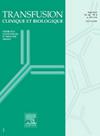Which is the best storage temperature to preserve the haemostatic quality of non-leukoreduced whole blood units collected under a military emergency protocol − Cold or room temperature?
IF 1.2
4区 医学
Q4 HEMATOLOGY
引用次数: 0
Abstract
Objectives
Emergency collection may be the only way to access blood when an urgent need arises, such as in a military setting. However, it is important to preserve any excess whole blood donations for future transfusion needs. Cold or room temperature (RT) storage has been reported in the literature. This raises the question of which storage temperature best preserves haemostatic properties of whole blood (WB). Our study investigated this question for storage times up to 48 h.
Methods
This comparison study used 30 bags of WB collected from eligible military personnel. WB bags were randomly stored at either 22 °C or 4 °C. Samples from each bag were taken immediately after blood collection and analysed again after 48 h storage. Analyses included: metabolic and haematological parameters, coagulation factors, thrombin generation potential and platelet function (platelet activity, clotting capacity and aggregometry).
Results
The overall quality of both storage conditions at 48 h was adequate according to metabolic parameters. Aggregometry was significantly affected in both groups. Clot stiffness was better preserved in WB stored at RT, however coagulation time was extended compared to storage at 4 °C. The platelet count was reduced in 4 °C. The thrombin generation potential was maintained irrespective of storage conditions.
Conclusion
The storage at RT offers encouraging in vitro results to promote its use to recover haemostatic functions. As both conservation temperature is acceptable, this will offer greater flexibility to access blood in a resource-limited environment. The choice of either temperature should depend on the frequency of patient admissions.
在军事应急方案下收集的非白细胞全血单位,保持其止血质量的最佳储存温度是低温还是室温?
目的:紧急采集可能是在紧急需要时获得血液的唯一途径,例如在军事环境中。然而,重要的是保存任何多余的全血供将来输血需要。冷或室温(RT)储存在文献中已有报道。这就提出了一个问题,即哪种储存温度最能保持全血(WB)的止血特性。我们的研究对长达48小时的储存时间进行了调查。方法:采用从符合条件的军人身上采集的30袋WB进行对比研究。WB袋随机存放于22°C或4°C。每个袋在采血后立即取标本,保存48小时后再次分析。分析包括:代谢和血液学参数、凝血因子、凝血酶生成潜力和血小板功能(血小板活性、凝血能力和聚集度)。结果:根据代谢参数,两种贮藏条件在48h时的整体质量均良好。两组患者的聚集性均受到显著影响。室温下储存的WB能更好地保存凝块硬度,但与4℃保存相比,凝固时间延长。血小板计数在4°C时减少。无论储存条件如何,凝血酶的生成潜力都保持不变。结论:体外RT储存对促进其止血功能的恢复具有积极的作用。由于两种保存温度都是可接受的,这将为在资源有限的环境中获取血液提供更大的灵活性。这两种温度的选择应取决于病人入院的频率。
本文章由计算机程序翻译,如有差异,请以英文原文为准。
求助全文
约1分钟内获得全文
求助全文
来源期刊
CiteScore
2.50
自引率
11.80%
发文量
234
审稿时长
36 days
期刊介绍:
Transfusion Clinique et Biologique, the official journal of the French Society of Blood Transfusion (SFTS):
- an aid to training, at a European level
- the only French journal indexed in the hematology and immunology sections of Current Contents
Transfusion Clinique et Biologique spans fundamental research and everyday practice, with articles coming from both sides. Articles, reviews, case reports, letters to the editor and editorials are published in 4 editions a year, in French or in English, covering all scientific and medical aspects of transfusion: immunology, hematology, infectious diseases, genetics, molecular biology, etc. And finally, a convivial cross-disciplinary section on training and information offers practical updates.
Readership:
"Transfusers" are many and various: anesthetists, biologists, hematologists, and blood-bank, ICU and mobile emergency specialists...

 求助内容:
求助内容: 应助结果提醒方式:
应助结果提醒方式:


